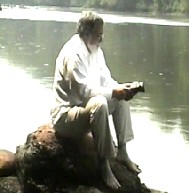It's All About Him: Hebrews -- Lesson 32
The Current Age
What does the Writer mean by this?
The Holy Spirit is signifying this, that the way into the holy place has not yet been disclosed while the outer tabernacle is still standing, which is a symbol for the present time. Accordingly both gifts and sacrifices are offered which cannot make the worshiper perfect in conscience, since they relate only to food and drink and various washings, regulations for the body imposed until a time of reformation. (Hebrews 9:8-10, NASB95)
He just described the arrangement of the tabernacle: an outer tabernacle and the Holy of Holies. How does he get from the physical description to "a symbol for the present time"? Why does the Writer refer to the tabernacle and not the temple?
First, I believe the Writer refers to the tabernacle over the temple in order to connect his words to the Scriptures. The tabernacle is what Moses built from what he saw in heaven and the Writer wants to connect everything that he says to that model. The temple is not an improved tabernacle, it is a tabernacle that cannot be moved and one that has been embellished by kings. The Writer of Hebrews wants his readers to concentrate on simple basics.
Second, the Writer is making the case that the Holy Spirit will imbue the Scriptures with multiple levels of meaning. I have discussed this before, and written about it at length in "Hints, Allegories, and Mysteries: The New Testament Quotes the Old." Here he is saying that among other things the tabernacle in Exodus is to be seen as a picture of the unfolding of mankind coming into a restored relationship with God. The outer court represents the separation between God and man. It represents the need for intercessors and a blood atonement. It represents the time of a privileged priesthood--no one could enter the tabernacle.
When Jesus died, He took, spiritually speaking, His blood into heaven and poured it at the base of the mercy seat of substance--just like the earthly high priest poured the goat's blood at the base of the shadow. The real has come, the outer tabernacle, as a symbol of the present age, no longer stands. This is the great and wonderful aspect of the New Covenant--We are the temple of the Holy Spirit. The inner place, where God dwells, is in the heart of the believer.
The magnitude of the change can be illustrated by comparing the events of Exodus 19 with those of Acts 2. It is not well known that the Feast of Pentecost celebrates the giving of the Law on Mt. Sinai--the birth of the Old Covenant. We do know that Acts 2 celebrates the birth of the New. We are, therefore, lead to compare the differences between the two events.
Here is a very brief summary of the flow of events when the Law came forth from Mount Sinai. The Lord told Moses that He desires to have a Â?nation of priestsÂ? (Exodus 19:6). A few days later, the Lord descended on Mount Sinai with fire, smoke, the sound of a trumpet, and other manifestations (Exodus 19:16-25). On the mount, the Lord spoke out loud the ten commandments to the people (Exodus 20:1-17). The people responded by drawing back and asking Moses to be a mediator. In the end, the people did not become a nation of priests. Rather, that responsibility fell to the descendants of Aaron.
LetÂ?s compare those events with the Day of Pentecost. Whereas a single fire descended and landed on the top of the mountain and before a barrier keeping the people away, when the Holy Spirit came, the fire separated and alighted on individual believers. This is an incredible statement of the new access to the Father in the New Covenant. The presence of God no longer must be remote and terrifying, but is now individual and within. Whereas the Lord spoke from Mount Sinai, it was the believers, filled and empowered by the Holy Spirit, who spoke. Whereas the ancient Israelites withdrew, on the Day of Pentecost, the people came close and 3,000 were saved. Indeed, all became priests (Revelation 5:9, 10). When Jesus died and took His own blood into the Holy Place in heaven, He established the New Covenant. Because the hearts of men could now be cleansed and healed, the Holy Spirit could now indwell every believer.
I will say this strongly. It is the Holy Spirit who is the key distinctive of the New Covenant over the Old. You might say that we are saved by faith. That is not new, because Abraham is the father of justification by faith (Genesis 15:6). Blood has provided a covering for sin since the Lord clothed Adam and Eve with animal skins. The LordÂ?s lovingkindness and mercy are expressions of His grace. Faith, blood, and grace are active principles in the Old Covenant. The new thing in Acts 2 is the indwelling, sanctifying, and empowering effect of the Holy Spirit made possible by the cleansing blood of Jesus the Messiah.
So we live in a new age. The age of access and the age of indwelling. My challenge to you and my challenge to myself is this: make this truth operational in your life. We bandy about terms like "we are a new creation." And we live the lives of non-believers. We live weed-choked lives. We must seek the continually filling and empowering of the Holy Spirit and recognize the unbelievable preciousness of that gift and what it cost to give it to us.
The outer tabernacle is gone.
---
Test everything. Cling to what is good.



0 Comments:
Post a Comment
<< Home